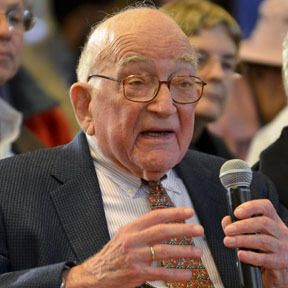A Short History of CISAC
A Short History of CISAC
The Center for International Security and Cooperation (CISAC) traces its origins to the Vietnam War and the mass teach-ins that took place on campus during that turbulent era. At one of the gatherings, political scientist John W. Lewis, a noted China scholar, met physicist Wolfgang (Pief) Panofsky, then director of the Stanford Linear Accelerator Center (SLAC), and Stanford law professor John Barton. The three men, Lewis recalls, found that the students had little knowledge about war and how security policies are developed. In response, the scholars decided to create a teaching environment in which students from different disciplines could examine international security matters and understand how government policy is formed.
In 1970, their class, "Arms Control and Disarmament," focused on nuclear weapons and efforts to control them through treaties and negotiations. Today, the descendant of that class is still team-taught by CISAC faculty every winter quarter under the name, "International Security in a Changing World." Over time, this course has influenced thousands of Stanford undergraduates.
In 1973, the Ford Foundation awarded Stanford a grant to develop a course on arms control and an accompanying textbook. International Arms Control: Issues and Agreements became the standard textbook on the subject. A year later, the foundation gave the fledgling program a five-year grant for training, research and outreach activities. In 1978, along with three other university-based centers, Stanford's "Arms Control Program" received Ford Foundation endowment funds that Stanford subsequently matched. When the match was finalized in 1983, Stanford's Center for International Security and Arms Control (CISAC) was established. Lewis and SLAC physicist Sidney D. Drell were the Center's first two co-directors, a structure maintained ever since.
From the beginning, CISAC has emphasized a three-part mission:
- To produce policy-relevant research on international security problems;
- To teach and train the next generation of security specialists;
- To influence policymaking in international security.
From inception, the Center focused on the study of U.S.-Soviet-China relations, arms control and nonproliferation, and the technical aspects of international security issues. In 1983, Carnegie Corporation of New York gave CISAC a grant to bring mid-career scientists to the Center to work on international security issues. Ever since, CISAC has brought scientists, social scientists and policy experts to the Center as fellows.
After Soviet Premier Mikhail Gorbachev came to power in 1985, CISAC was able to foster deeper ties with the Soviet academic and policymaking communities. In 1990, when Gorbachev visited Stanford and gave a lecture on cooperation and reconciliation between the two longtime adversaries, he singled out the efforts of Stanford and CISAC researchers in bridging Cold War hostilities.

The end of the Cold War reduced many security dangers but increased others. As new challenges emerged, CISAC's research agenda adapted accordingly. New areas of study included the safeguarding of nuclear weapons and the study of internal and regional wars, peacekeeping operations, and peace settlements.
In 1998, CISAC moved to larger quarters in Encina Hall and changed its name, in reflection of its broadened mandate, to the Center for International Security and Cooperation. The Center continued to mentor visiting fellows and in 2000 expanded its teaching activities by establishing an undergraduate honors program in international security studies.
After the terrorist attacks on 9/11, the center's research agenda broadened again to include questions of terrorism and counterterrorism. Martha Crenshaw developed her student-led Mapping Terrorist Organizations project and work at the Center continues to reflect the security challenges worldwide. For example, senior scholars such as CISAC'S William J. Perry and George Shultz at Hoover, the center's first co-directors Sid Drell and John Lewis, and former co-director Siegfried S. Hecker, former visiting scholar James Goodby, and faculty members David Holloway and Scott D. Sagan, are all working with a vision to eliminate nuclear weapons worldwide.
Today, CISAC is co-directed by Rod Ewing and Scott Sagan, and it is building on historic strengths in arms control to seek solutions to the many longstanding and emerging challenges associated with an increasingly complex world. Among them are cybersecurity, war and civil conflict, migration and transnational flows, public health and biosecurity. International norms and ethics, insurgency and homeland security, and nuclear proliferation are also hallmarks of CISAC research.
Through education, scholarship, and Track II diplomacy, CISAC strives to influence the policymaking agenda in the United States and abroad. We are guided in this effort by our longstanding belief that a commitment to rigorous scholarship, openness to new ideas, and lively intellectual exchange can spur the creation and spread of knowledge to help build a safer world.

